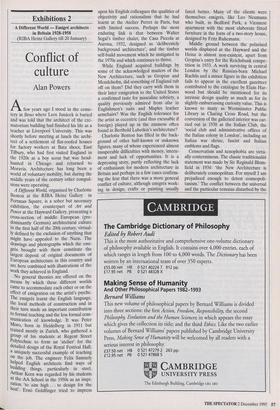Exhibitions 2
A Different World — Emigre architects in Britain 1928-1958 (RIBA Heinz Gallery till 20 January)
Conflict of culture
Alan Powers
Afew years ago I stood in the ceme- tery in Brno where Leos Janacek is buried and was told that the architect of the cre- matorium building had finished his life as a teacher at Liverpool University. This was shortly before meeting at lunch the archi- tect of a settlement of flat-roofed houses for factory workers at Bata shoes, East Tilbury, who had first visited England in the 1920s as a boy scout but was head- hunted in Chicago and returned to Moravia. Architecture has long been a world of voluntary mobility, but during the middle years of the century other compul- sions were operating.
A Different World, organised by Charlotte Benton at the RIBA Heinz Gallery in Portman Square, is a sober but necessary exhibition, the counterpart of Art and Power at the Hayward Gallery, presenting a cross-section of middle European (pre- dominantly German) architectural culture in the first half of the 20th century, virtual- ly defined by the exclusion of anything that might have appealed to the Nazis. The drawings and photographs which the emi- gres brought with them constitute the largest deposit of original documents of European architecture in this country and are here combined with illustrations of the work they achieved in England. No general theories are offered on the means by which these different worlds came to accommodate each other or on the effect of emigration on the artist's psyche. The emigres learnt the English language, the local methods of construction and in their turn made an important contribution to formal teaching and the less formal com- munication of knowledge. It was Peter Moro, born in Heidelberg in 1911 but trained mostly in Zurich, who gathered a _group of his students at Regent Street Polytechnic to form an 'atelier' for the detailed design of the Royal Festival Hall, a uniquely successful example of teaching on the job. The engineer Felix Samuely helped English architects find ways of building things, particularly in steel. Arthur Korn was regarded by his students at the AA. School in the 1950s as an inspi- ration 'to aim high . . . to design for the best'. Erna Goldfinger tried to impress upon his English colleagues the qualities of objectivity and rationalism that he had learnt at the Atelier Perret in Paris, but with limited success. Perhaps the most enduring link is that between Walter Segal's timber chalet, the Casa Piccola at Ascona, 1932, designed as 'deliberately background architecture', and the timber self-build movement which he instigated in the 1970s and which continues to thrive.
While England acquired buildings by some of the acknowledged masters of the New Architecture, such as Gropius and Mendelsohn, did something of England rub off on them? Did they carry with them in their later emigration to the United States a confirmed taste for masculine sobriety, a quality previously admired from afar in Englishmen's suits and Maples leather armchairs? Was the English tolerance for the artist as eccentric (and thus excusable if foreign) played up in the zaniness often found in Berthold Lubetkin's architecture?
Charlotte Benton has filled in the back- ground of other half-known or unknown figures, many of whom experienced almost insuperable difficulties with money, intern- ment and lack of opportunities. It is a depressing story, partly reflecting the lack of enthusiasm for modern architecture in Britain and perhaps in a few cases confirm- ing the fear that there was a more general conflict of culture, although emigres work- ing in design, crafts or painting usually fared better. Many of the clients were themselves emigres, like Leo Neumann who built, in Bedford Park, a Viennese apartment with the most elaborate fitted furniture in the form of a two-story house, designed by Fritz Ruhemann.
Middle ground between the polarised worlds displayed at the Hayward and the Heinz is almost non-existent, apart from Gropius's entry for the Reichsbank compe- tition in 1933. A work surviving in central London by the Russian-born Michael Rachlis and a minor figure in the exhibition fails to appear in the excellent gazetteer contributed to the catalogue by Elain Har- wood but should be mentioned for its intrinsic design quality as much as for its slightly embarrassing curiosity value. This is known to many as Westminster Public Library in Charing Cross Road, but the conversion of the galleried interior was car- ried out in 1938 as the Italian Club, the `social club and administrative offices of the Italian colony in London', including an Italian war shrine, fascist and Italian emblems and flags.
Conservatism and xenophobia are virtu- ally conterminous. The classic traditionalist statement was made by Sir Reginald Blom- field in 1934: 'the New Architecture is deliberately cosmopolitan, For myself I am prejudiced enough to detest cosmopoli- tanism.' The conflict between the universal and the particular remains disturbed by the memories of the 1930s. Britain is now a net exporter of architecture which qualifies for the dog-eared label of 'Modern', an indica- tion that architecture itself is largely a dif- ferent world within the confines of a culture that values locality and tradition without knowing how to articulate them.











































































 Previous page
Previous page